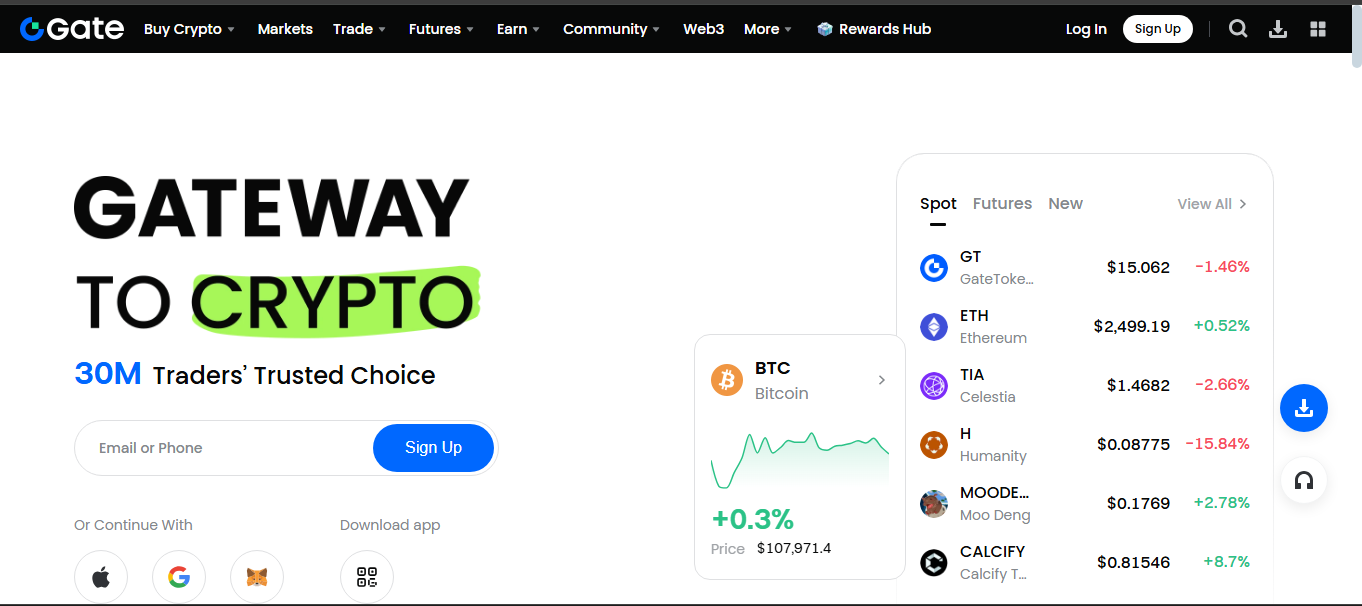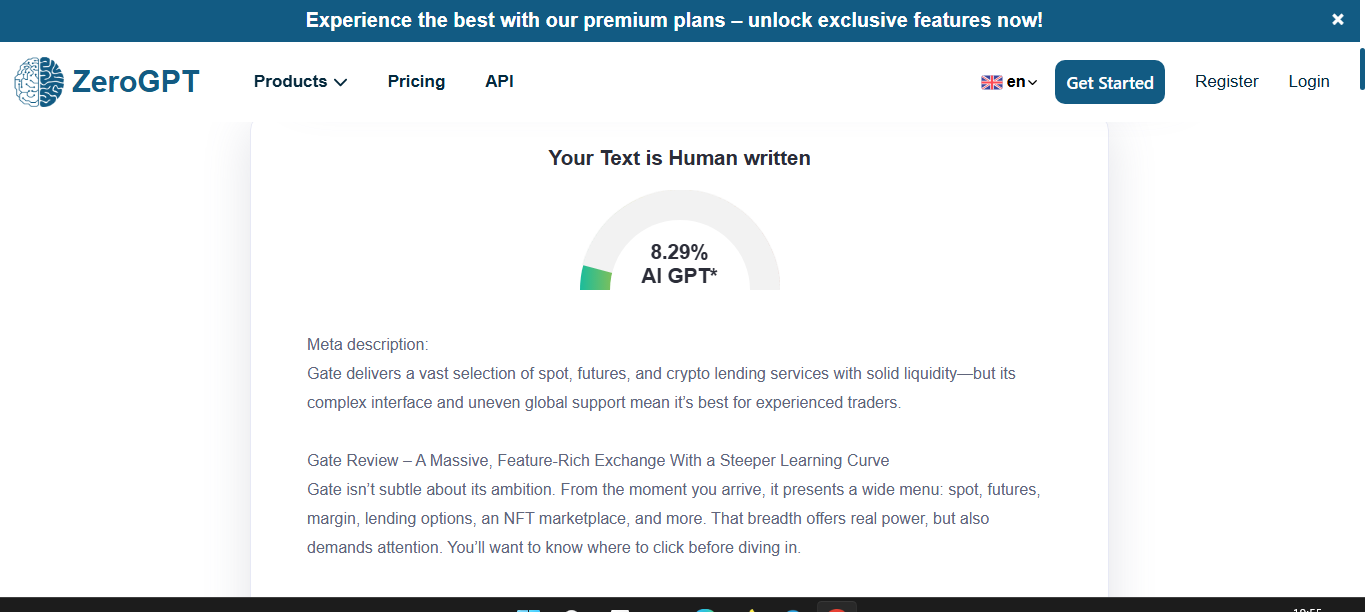Gate Review - A Massive, Feature-Rich Exchange With a Steeper Learning Curve

Gate isn’t subtle about its ambition. From the moment you arrive, it presents a wide menu: spot, futures, margin, lending options, an NFT marketplace, and more. That breadth offers real power, but also demands attention. You’ll want to know where to click before diving in.
Gate has been around since 2013, carving out a reputation among altcoin hunters and leveraged traders. It thrives on choice: hundreds of token pairs, strong funding channels, and features for most types of traders. But, with so much to explore, it's possible to misstep if you're not paying attention.
An Overwhelming Catalog of Products
Gate puts nearly everything on the table. Spot trading spans major currencies and niche altcoins. Futures markets deliver 10× to 100× leverage. Margin trading lets you borrow to increase exposure. Lending pools, interest-bearing accounts, and tokenized USDT savings accounts sit under “Earn.” There’s even an NFT marketplace and integrations with DeFi platforms.
That’s exciting if you enjoy experimenting and customizing your setup. But each new tab means choices to make: spot order type, margin ratio, funding cycle, lock-up duration, yield rates - each one matters. Beginners might feel paralyzed; experienced traders could call it a playground.
Liquidity and Execution Trade-offs
Gate’s strength lies in depth, especially for top tokens. BTC and ETH book liquidity is consistent, which makes large trades behave predictably. Many altcoins enjoy decent volume too, though newer listings can be thinner and thus more prone to slippage and spread volatility.
The futures market reflects this: popular contracts retain stability, while smaller ones might echo small-engine jet turbulence - fast and erratic. If you're executing large, leveraged positions, monitoring order book depth becomes crucial.
Competitive Fees - and a Few Fine Print Items
Trading costs are low. Maker fees can drop near 0.05%, taker around 0.10% - attractive for active traders. Funding, margin borrowing, and lending rates shift depending on market conditions, so variability matters. Choosing the cheapest pool or optimal funding cycle can boost returns but also demands vigilance.
Fiat gateways exist in some jurisdictions, but they come with extra fees - often 2–4% depending on provider and region. Deposits are mostly crypto, and withdrawal speeds match industry norms - usually 30–60 minutes unless chains get congested.
Interface: Deeply Functional, Not Beginner‑Friendly
Gate’s platform is packed. You get detailed order books and advanced charting tools. Custom layout lets frequent users personalize screens. It’s powerful for seasoned traders - but first-time users can easily miss spots like leverage settings or order type selection.
The mobile app mirrors that depth, which helps if you're managing positions on the go. But crowds of options mean mistakes are easy: an unintended margin order here, a loan initiated there. Unlike simple wallets or exchanges, this feels like a semi-pro toolkit.
Security and Regulation Considerations
Gate follows two-factor authentication, uses multi-tiered cold storage for funds, and offers withdrawal whitelists. There’s no major hack in its history, offering a solid track record for a platform of this size.
But Gate isn’t licensed in most major markets. It operates offshore with local registrations where possible. For users in tightly regulated regions, the lack of FCA, SEC, or MAS oversight might be uncomfortable. No amount of backups can fully replace the confidence of covered deposits under a national regulator.
Who Gate Suits - and Who It Doesn’t
Gate is a flexible beast that thrives in certain hands. It’s ideal for:
- Active traders who work with many coin pairs and use multiple features
- Leveraged traders who seek spot plus futures access under one account
- Yield hunters navigating lending pools and DeFi integrations
But it’s ill-suited for:
- Casual buyers who just want to buy BTC or ETH with fiat and store them for years
- Newcomers easily confused by feature overload
- Investors needing regulated custody or deposit insurance
Gate stretches across the middle ground between traditional exchanges and DeFi apps. If that’s your canvas, it can be compelling. If not, its size becomes noise.
Getting Started and Staying Safe
Account creation follows the usual path - email, password, optional 2FA, and identity verification for unlocking features or raising withdrawal limits. From there, it’s up to you whether to fund your wallet, dive into spot, borrow margin, stake coins, lend in pools, or buy NFTs.
Smart users start small and explore piece by piece. Deposits go in. Spots trade. Withdraw profits or rebalance once a week. If you dive into margin or lending, assign strict limits, track rates, and move funds when the risk isn’t worth the yield.
Final Verdict
Gate is ambitious and faintly relentless - a Swiss army knife of crypto tools in a single account. Its largest strength is variety; its biggest weakness is decision complexity. Traders who can handle that spectrum without losing discipline find a lot to like. Everyone else risks getting lost in a labyrinth of choices.
If you want a one-stop exchange with serious depth, Gate has nearly everything - just be ready to pay attention. If you prefer a simpler, more assured journey, you may prefer to let Gate be a side platform, not your main one.

Disclaimer
“This content is for informational purposes only and does not constitute financial advice. Please do your own research before investing.”
.png)







%203.svg)
%203.svg)




















